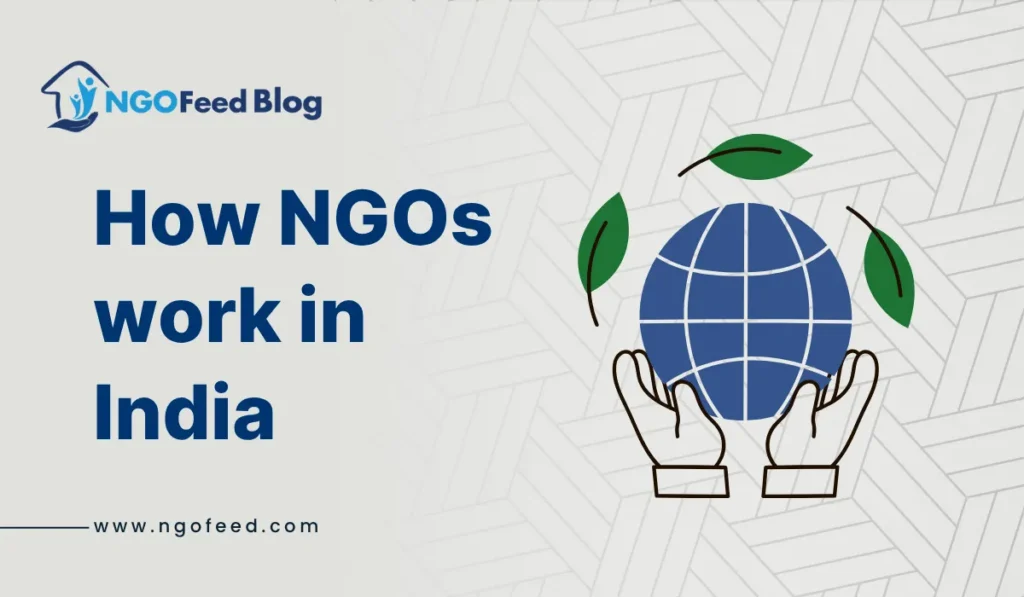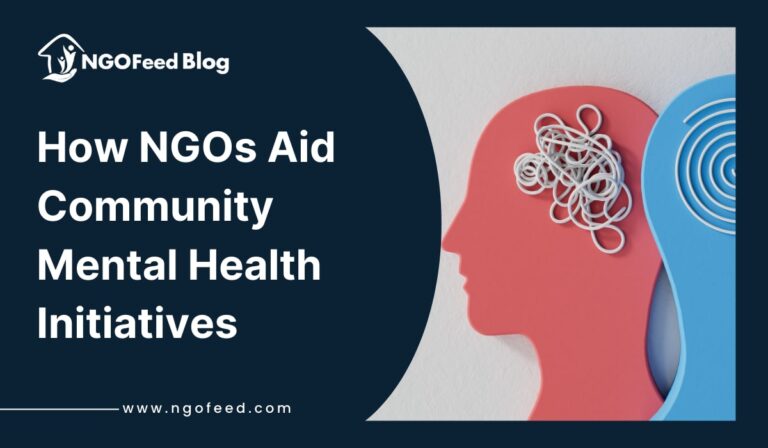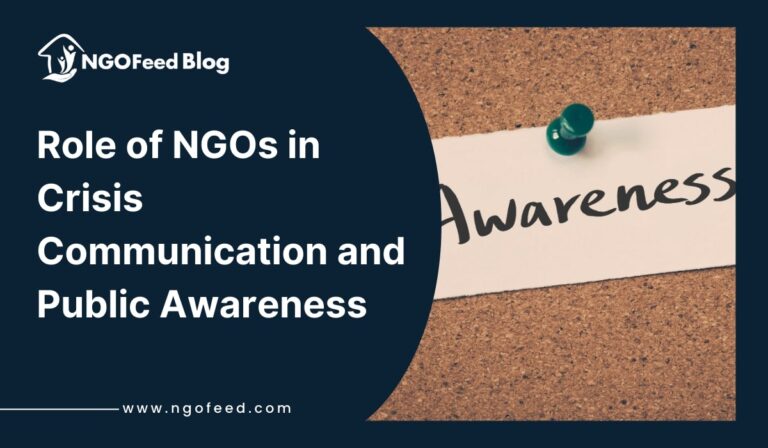How NGOs Work in India: India has one of the largest and most diverse non-governmental organization (NGO) networks globally. NGOs address various issues, including rural education, women’s empowerment, health, the environment and disaster relief, serving as an intermediary between the government’s people-centered initiatives and the communities that need them. NITI Aayog’s NGO Darpan Portal states there are more than 1.6 million registered NGOs in India, nearly one for every 800 citizens. While they differ in size and purpose, they all have one thing in common: they provide inclusive, sustainable and people-centered development. The following article examines how NGOs work in India, including structure, functions, funding models and partnerships and explains why they are critical to creating a strong nation.
What Is an NGO and How It Functions
An NGO (Non-Governmental Organization) is a non-profit entity that operates independently of the government but works in alignment with social, developmental or humanitarian goals.
Legal Definition and Structure
In India, NGOs are legally registered under one of the following acts:
- The Societies Registration Act, 1860
- The Indian Trusts Act, 1882
- The Companies Act, 2013 (Section 8 Companies)
Each framework governs how an NGO is managed, funded and audited.
Core Functions of NGOs
- Service Delivery: Implementing programs in areas like education, health and sanitation.
- Advocacy: Campaigning for social reforms and policy changes.
- Awareness Building: Educating citizens about their rights, duties and government schemes.
- Research & Policy Support: Conducting studies to inform development strategies.
- Capacity Building: Training communities to become self-sustainable.
Importance of NGOs in India
NGOs are not merely service providers; they are enablers of change. Their work complements the government’s vision and ensures that development reaches even the most marginalized populations.
- Grassroots Empowerment: NGOs work directly with communities, empowering them to participate in local governance, education and livelihood development.
- Filling Government Gaps: While government programs cover vast areas, NGOs address micro-level issues that large bureaucratic systems might overlook.
- Promoting Human Rights and Equality: Organizations like CRY (Child Rights and You) and ActionAid India advocate for child protection, gender equality and social inclusion.
- Innovation in Development: Many NGOs pilot innovative solutions that later become part of government policies such as Pratham’s “Teaching at the Right Level” model, now adopted by multiple state governments.
- Strengthening Civil Society: NGOs create an informed and engaged citizenry that can hold institutions accountable and promote transparency.
The Role of NGOs in Different Sectors
The diversity of India’s NGO ecosystem can be seen through their wide-ranging focus areas.
- Education and Skill Development: NGOs like Pratham, Teach For India and Room to Read focus on improving literacy, digital learning and vocational skills. They work closely with schools and communities to ensure quality education for all.
- Healthcare and Nutrition: Organizations such as Smile Foundation, CARE India and Doctors For You deliver essential healthcare, maternal support and disease prevention campaigns in underserved areas.
- Women Empowerment: Groups like SEWA (Self Employed Women’s Association) and Snehalaya promote women’s rights, entrepreneurship and safety, encouraging economic independence.
- Environment and Sustainability: NGOs like Centre for Science and Environment (CSE) and WWF-India focus on climate change mitigation, afforestation and sustainable farming practices.
- Disaster Relief and Humanitarian Aid: When calamities strike, from floods to pandemics, organizations such as Goonj, Red Cross India and Save the Children mobilize resources for emergency response and rehabilitation.
- Rural Development and Livelihood: NGOs like BAIF Development Research Foundation and Gram Vikas support sustainable agriculture, water management and income generation in rural India.
Challenges Faced by NGOs in India
While NGOs are integral to national progress, their work is not without hurdles.
- Funding Limitations: Irregular donations, dependence on foreign contributions and limited CSR partnerships often constrain their scalability. Recent amendments to the Foreign Contribution Regulation Act (FCRA) have also affected many small NGOs’ operations.
- Regulatory Complexities: NGOs face multiple compliance requirements under different laws, such as maintaining separate accounts for domestic and foreign funds and filing regular reports to authorities.
- Accountability and Transparency: Public trust is vital. However, a few cases of fund misuse by unethical entities have led to stricter scrutiny and a loss of donor confidence.
- Human Resource Challenges: Attracting and retaining skilled professionals in non-profit work can be difficult due to limited financial incentives compared to corporate sectors.
- Sustainability Issues: Many NGOs struggle to design financially sustainable models and depend heavily on external funding.
How NGOs Work in India: Structure, Funding, and Collaboration
NGOs in India typically follow a three-tier operational mode:l governance, implementation and community participation.
1. Organizational Structure
- Governing Board/Trustees: Strategic decision-makers and custodians of the NGO’s mission.
- Executive Team: Handles administration, fundraising and partnerships.
- Field Staff & Volunteers: Execute projects and monitor community outcomes.
2. Funding Sources
NGOs in India rely on multiple funding channels:
- Individual Donations: Contributions from citizens and philanthropists.
- Corporate CSR Funds: Partnerships under Section 135 of the Companies Act, 2013 mandate corporates to spend 2% of profits on CSR.
- Government Grants: Funding from central and state welfare schemes.
- Foreign Donations: Regulated under the FCRA Act, 2010.
- Crowd funding: Growing as a digital trend, especially post-pandemic.
3. Collaboration Models
- Public-Private Partnerships (PPP): NGOs work with government departments on implementation (e.g. Mid-Day Meal Scheme).
- Corporate Collaboration: Joint initiatives for CSR-based development programs.
- Community-Based Models: Empowering local communities to design and manage their own development solutions.
- Knowledge Networks: NGOs collaborate with research bodies and think tanks for data-driven advocacy.
Major NGOs and Their Work
Here are some notable NGOs demonstrating diverse models of impact:
| NGO Name | Focus Area | Key Contribution |
| Pratham | Education | Improved learning outcomes for millions of children. |
| Goonj | Rural Development | Transforms urban waste into rural resources. |
| Smile Foundation | Health & Education | Runs mobile healthcare and educational initiatives. |
| Akshaya Patra Foundation | Nutrition & Education | World’s largest school meal program. |
| HelpAge India | Elderly Welfare | Supports senior citizens’ healthcare and rights. |
| SEWA | Women Empowerment | Promotes self-employment for women. |
Their Work and Challenges: Case Study
Case Study: Goonj – Turning Urban Waste into Rural Wealth
Founded by Anshu Gupta in 1999, Goonj addresses poverty and dignity by channeling urban surplus (clothes and materials) to rural areas.
Work:
- Collects and redistributes urban waste to rural communities in exchange for local development work.
- Runs the “Cloth for Work” initiative, enabling people to earn clothing and essentials through community service.
Impact:
- Reached over 4,000 villages across India.
- Recognized by the Ramon Magsaysay Award (2015) for social entrepreneurship.
Challenges:
- Logistics management across diverse geographies.
- Ensuring consistent donor engagement and sustainable funding.
Additional Insights: Trends and Expert Perspectives
1. Digital Transformation in NGOs
With the rise of technology, NGOs are shifting to digital tools for communication, fundraising and impact tracking.
Platforms like NGOFeed help NGOs boost visibility, publish verified information and connect with global networks.
2. Focus on Transparency and Impact Measurement
Modern donors demand measurable results. NGOs are now adopting impact assessment frameworks like Social Return on Investment (SROI) and digital dashboards for real-time tracking.
3. Collaboration for Sustainable Development Goals (SDGs)
Many NGOs align their work with the UN SDGs, partnering with corporates and governments to achieve shared sustainability targets.
4. Youth Engagement
A growing number of youth volunteers and social entrepreneurs are joining the nonprofit sector, reshaping India’s civic ecosystem.
Conclusion
NGOs form the heart of India’s development framework connecting people, policies and purpose. They complement government initiatives, innovate local solutions and empower communities to thrive independently.
Despite challenges like funding shortages and regulatory complexities, the resilience and passion of India’s NGO sector continue to drive meaningful progress.
As India moves toward its 2047 development vision, strengthening NGO capacity, embracing digital transformation and ensuring transparency will be key to sustainable growth.
Platforms like NGOFeed play a crucial role in this journey empowering, educating and connecting NGOs to create a more equitable and aware society.
Frequently Asked Questions (FAQs)
1. How are NGOs formed and registered in India?
NGOs can be registered as a Society, Trust or Section 8 Company, depending on their structure and objectives. Each form has specific legal and compliance requirements.
2. How do NGOs receive funding?
Funding comes from individuals, CSR donations, government grants and international donors under the FCRA Act.
3. What challenges do NGOs face in India?
Key challenges include limited funding, complex compliance processes and lack of skilled manpower.
4. What is the future of NGOs in India?
The future lies in digital innovation, collaboration with corporates and government and data-driven development for measurable impact.
5. How does NGOFeed support NGOs?
NGOFeed connects NGOs with verified information, digital visibility tools and resources to improve transparency and outreach.










